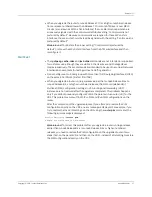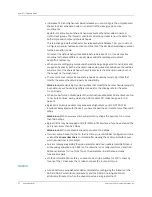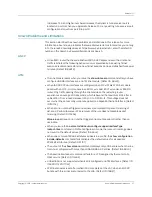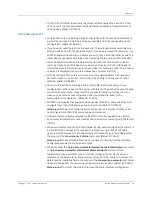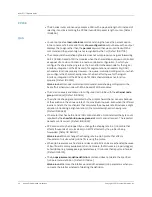
Copyright © 2010, Juniper Networks, Inc.
Known Behavior
33
Release 11.1.1
When the physical port value is greater than 7:
−
An incorrectly configured NAS-Port attribute format results if you use either the
radius nas-port-format 0ssssppp
or
radius nas-port-format ssss0ppp
command.
−
An incorrectly configured Calling-Station-ID attribute results if you use either the
radius calling-station-format fixed-format
command or the
radius
calling-station-format fixed-format-adapter-embedded
command.
Work-around
: Use the following commands on routers that have line modules with
more than 7 physical ports:
−
To configure the NAS-Port attribute format, use the
radius nas-port-format
extended [ atm | ethernet ]
command.
−
To configure the Calling-Station-ID attribute format, use the
radius
calling-station-format fixed-format-adapter-new-field
command.
SNMP
z
SNMP MIBs
Information about all the SNMP MIBs (both standard and proprietary) that the router
supports in this release is available in the MIB directory in the SW_Image_CD-2 folder
of the JunosE Software image bundle, which you downloaded from the Juniper
Networks website, that contains the release file for E120 and E320 routers.
z
Some Juniper Networks SNMPv1-formatted traps contain an incorrect object
identifier (OID) in the SNMPv1-Trap-PDU enterprise field. An SNMPv2 trap is typically
identified by an OID that ends in the form ...x.y.z.0.n. This OID appears, in full, as the
value of the snmpTrapOID.0 object in the varbind list of an SNMPv2-formatted trap.
In the corresponding SNMPv1-formatted trap, this OID is broken down into
subcomponents that fill the SNMPv1-Trap-PDU enterprise field (...x.y.z) and specific
trap number field (n); the zero is unused.
The SNMPv1-formatted versions of the following Juniper Networks traps incorrectly
contain ...x.y.z.0 in the SNMPv1-Trap-PDU enterprise field. That is, a zero is
mistakenly appended to the correct enterprise OID value.
Work-around
: Use the OIDs that the SNMP agent sends.
Trap Name
Expected Enterprise OID
Enterprise OID Sent by SNMP Agent
junidApsEventSwitchover
.1.3.6.1.4.1.4874.3.2.2.1.2
.1.3.6.1.4.1.4874.3.2.2.1.2.0
junidApsEventModeMismatch
.1.3.6.1.4.1.4874.3.2.2.1.2
.1.3.6.1.4.1.4874.3.2.2.1.2.0
junidApsEventChannelMismatch
.1.3.6.1.4.1.4874.3.2.2.1.2
.1.3.6.1.4.1.4874.3.2.2.1.2.0
junidApsEventPSBF
.1.3.6.1.4.1.4874.3.2.2.1.2
.1.3.6.1.4.1.4874.3.2.2.1.2.0
junidApsEventFEPLF
.1.3.6.1.4.1.4874.3.2.2.1.2
.1.3.6.1.4.1.4874.3.2.2.1.2.0
juniAddressPoolHighAddrUtil
.1.3.6.1.4.1.4874.2.2.21.3
.1.3.6.1.4.1.4874.2.2.21.3.0
juniAddressPoolAbatedAddrUtil
.1.3.6.1.4.1.4874.2.2.21.3
.1.3.6.1.4.1.4874.2.2.21.3.0
juniAddressPoolNoAddresses
.1.3.6.1.4.1.4874.2.2.21.3
.1.3.6.1.4.1.4874.2.2.21.3.0
juniDhcpLocalServerPoolHighAddrUtil
.1.3.6.1.4.1.4874.2.2.22.3
.1.3.6.1.4.1.4874.2.2.22.3.0
juniDhcpLocalServerPoolAbatedAddrUtil
.1.3.6.1.4.1.4874.2.2.22.3
.1.3.6.1.4.1.4874.2.2.22.3.0
juniDhcpLocalServerPoolNoAddresses
.1.3.6.1.4.1.4874.2.2.22.3
.1.3.6.1.4.1.4874.2.2.22.3.0
pimNeighborLoss
.1.3.6.1.3.61.1
.1.3.6.1.3.61.1.0









